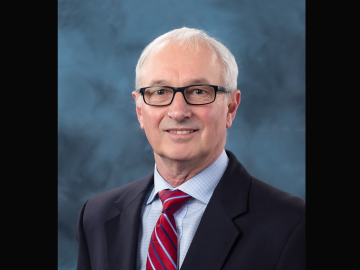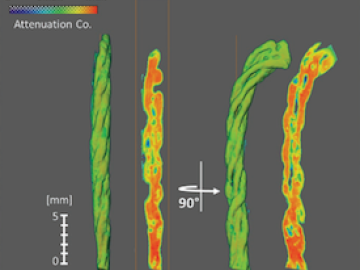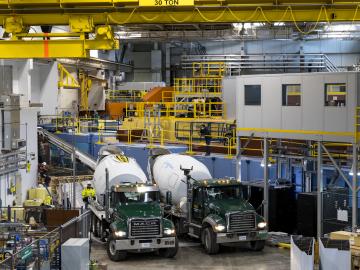
Filter News
Area of Research
- (-) Isotopes (2)
- (-) National Security (36)
- (-) Neutron Science (127)
- Advanced Manufacturing (8)
- Biology and Environment (38)
- Computational Biology (1)
- Computational Engineering (2)
- Computer Science (10)
- Electricity and Smart Grid (3)
- Energy Science (149)
- Functional Materials for Energy (1)
- Fusion and Fission (14)
- Fusion Energy (8)
- Isotope Development and Production (1)
- Materials (133)
- Materials Characterization (1)
- Materials for Computing (20)
- Materials Under Extremes (1)
- Mathematics (1)
- Nuclear Science and Technology (18)
- Nuclear Systems Modeling, Simulation and Validation (1)
- Quantum information Science (4)
- Sensors and Controls (1)
- Supercomputing (74)
- Transportation Systems (2)
News Topics
- (-) Advanced Reactors (2)
- (-) Artificial Intelligence (18)
- (-) Clean Water (2)
- (-) Cybersecurity (19)
- (-) Grid (6)
- (-) Materials Science (25)
- (-) Microscopy (3)
- (-) Neutron Science (120)
- (-) Transportation (7)
- 3-D Printing/Advanced Manufacturing (8)
- Big Data (8)
- Bioenergy (10)
- Biology (11)
- Biomedical (22)
- Biotechnology (2)
- Buildings (1)
- Chemical Sciences (5)
- Composites (1)
- Computer Science (31)
- Coronavirus (12)
- Energy Storage (9)
- Environment (14)
- Exascale Computing (1)
- Fossil Energy (1)
- Frontier (2)
- Fusion (2)
- High-Performance Computing (6)
- Hydropower (1)
- Irradiation (1)
- Isotopes (25)
- Machine Learning (15)
- Materials (20)
- Mathematics (1)
- Nanotechnology (11)
- National Security (36)
- Nuclear Energy (10)
- Partnerships (5)
- Physics (10)
- Polymers (1)
- Quantum Computing (1)
- Quantum Science (8)
- Security (12)
- Simulation (1)
- Space Exploration (6)
- Summit (7)
Media Contacts

To solve a long-standing puzzle about how long a neutron can “live” outside an atomic nucleus, physicists entertained a wild but testable theory positing the existence of a right-handed version of our left-handed universe.

How an Alvin M. Weinberg Fellow is increasing security for critical infrastructure components

It’s a simple premise: To truly improve the health, safety, and security of human beings, you must first understand where those individuals are.

ORNL researchers used the nation’s fastest supercomputer to map the molecular vibrations of an important but little-studied uranium compound produced during the nuclear fuel cycle for results that could lead to a cleaner, safer world.

A team of researchers has developed a novel, machine learning–based technique to explore and identify relationships among medical concepts using electronic health record data across multiple healthcare providers.

Unequal access to modern infrastructure is a feature of growing cities, according to a study published this week in the Proceedings of the National Academy of Sciences

From helping 750 million viewers watch Princess Diana’s wedding to enabling individual neutron scientists observe subatomic events, Graeme Murdoch has helped engineer some of the world’s grandest sights and most exciting scientific discoveries.

Textile engineering researchers from North Carolina State University used neutrons at Oak Ridge National Laboratory to identify a special wicking mechanism in a type of cotton yarn that allows the fibers to control the flow of liquid across certain strands.

More than 50 current employees and recent retirees from ORNL received Department of Energy Secretary’s Honor Awards from Secretary Jennifer Granholm in January as part of project teams spanning the national laboratory system. The annual awards recognized 21 teams and three individuals for service and contributions to DOE’s mission and to the benefit of the nation.

Cement trucks entering and exiting the Spallation Neutron Source are a common sight as construction of the VENUS neutron imaging beamline progresses. Slated for completion and commissioning in 2024-2025, VENUS is the twentieth neutron instrument at SNS and will offer many new capabilities.


